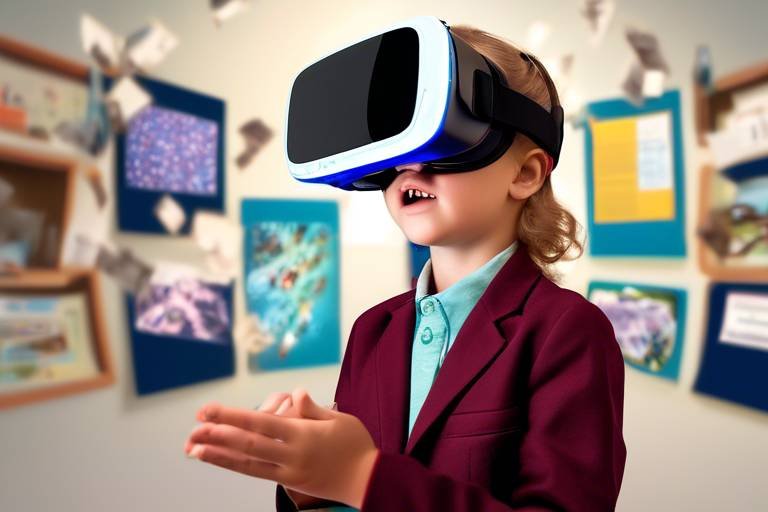The Role of Augmented Reality in Interior Design
In today's rapidly evolving technological landscape, augmented reality (AR) is making waves in various industries, and interior design is no exception. Imagine being able to see a new sofa in your living room before you even make the purchase. With AR, this is not just a dream—it's a reality! This innovative technology is revolutionizing the way designers and clients interact, allowing for a more immersive and engaging experience. By overlaying digital elements onto the real world, AR enhances visualization, improves client engagement, and streamlines the design process, making it an invaluable tool for modern interior designers.
The integration of AR into interior design is akin to having a magic window into the future of your space. Gone are the days of relying solely on swatches and fabric samples. Instead, clients can now visualize how different elements will look in their actual environment, leading to more informed decisions. This not only reduces the guesswork but also increases client satisfaction, as they can see their ideas come to life right before their eyes. So, how does augmented reality achieve this? Let's dive deeper into the fascinating world of AR and explore its benefits for interior design.
Augmented reality is a technology that overlays digital information onto the real world, providing users with an interactive experience that enhances their perception of their environment. With AR, digital images, sounds, and other sensory stimuli are integrated into the real world, allowing users to experience a blended reality. This technology has evolved significantly over the years, from simple smartphone applications to sophisticated systems that can transform entire rooms. As a result, interior designers can leverage AR tools to create stunning visualizations that captivate their clients.
The benefits of augmented reality in interior design are numerous and impactful. Here are some key advantages:
- Improved Visualization: Clients can see how furniture and decor will look in their space, reducing uncertainty and increasing satisfaction with design choices before any physical changes are made.
- Enhanced Client Communication: AR tools facilitate clearer discussions between designers and clients, ensuring that everyone is on the same page regarding design preferences.
- Real-time Modifications: Designers can make instant changes in AR, allowing clients to see how different colors, materials, or layouts would appear in their actual environment.
- Increased Client Engagement: AR encourages clients to actively participate in the design process, making it easier for them to express their preferences and ideas.
- Streamlined Design Process: By utilizing AR, designers can save time and resources, as clients can visualize the final outcome without the need for extensive physical samples or mock-ups.
One of the most significant advantages of AR in interior design is enhanced visualization. Imagine walking into your home and using your smartphone or AR glasses to see how a new piece of furniture would look in your living room. This technology allows clients to visualize their spaces in real-time, reducing uncertainty and increasing satisfaction with design choices before any physical changes are made. It’s like having a personal designer at your fingertips, ready to help you create your dream space.
Another powerful feature of AR is the ability to make real-time modifications. Designers can instantly change colors, materials, or layouts within the AR environment. This immediacy fosters a collaborative design process, allowing clients to see how their ideas can be implemented on the spot. For example, if a client is unsure about the color of a wall, the designer can quickly adjust it in the AR model, providing immediate feedback and helping clients feel more involved in the decision-making process.
AR tools also encourage increased client engagement. When clients can actively participate in the design process, they are more likely to express their preferences and ideas, leading to more personalized results. This engagement transforms the traditional designer-client relationship into a collaborative partnership, where both parties work together to create a space that truly reflects the client’s style and needs.
By utilizing AR, designers can significantly streamline the design process. Clients can visualize the final outcome without the need for extensive physical samples or mock-ups, saving both time and resources. This efficiency not only speeds up project timelines but also reduces costs, making AR a win-win solution for designers and clients alike.
Various interior design firms have successfully integrated AR into their workflows, demonstrating its effectiveness in enhancing client experiences and improving project efficiency. For instance, several companies have pioneered the use of AR, showcasing how the technology can facilitate better decision-making and streamline collaboration between designers and clients. These case studies reveal valuable insights into the challenges and successes of implementing AR, providing guidance for other designers looking to adopt this innovative technology.
As technology continues to evolve, the future of augmented reality in interior design looks promising. Potential advancements could further enhance the design process and client experience. Imagine walking into a room and having AR not only show you potential designs but also suggest furniture based on your preferences, budget, and even the latest trends. The possibilities are endless, and as AR technology continues to develop, it is set to become an integral part of the interior design landscape.
- What is augmented reality? Augmented reality is a technology that overlays digital information onto the real world, enhancing the user's perception of their environment.
- How does AR benefit interior design? AR improves visualization, enhances client communication, allows for real-time modifications, increases client engagement, and streamlines the design process.
- Can I use AR on my smartphone? Yes! Many AR applications are available for smartphones, allowing you to visualize designs in your own space easily.
- Is AR expensive to implement for designers? While there may be initial costs associated with AR tools, the long-term benefits, including time savings and increased client satisfaction, often outweigh these costs.

Understanding Augmented Reality
Augmented reality (AR) is a fascinating technology that blends the digital and physical worlds, creating an interactive experience that enhances our perception of reality. Imagine walking into your living room and seeing how a new sofa would look in your space without ever having to move a single piece of furniture. That's the magic of AR! It allows users to visualize digital information in real-time, overlaying graphics, sounds, and other sensory enhancements onto the real world.
To put it simply, AR enriches our environment by adding layers of digital content that can be interacted with. This technology is not just limited to gaming or entertainment; it has found a significant place in various fields, including interior design. By using AR, designers can create immersive experiences that help clients make informed decisions about their spaces. The technology typically requires a device, such as a smartphone or tablet, equipped with a camera and AR software. When the device scans the environment, it can place virtual objects in the real world, allowing users to see how different elements will fit together.
One of the most exciting aspects of AR is its ability to facilitate collaboration between designers and clients. With AR tools, clients can visualize design concepts in their actual space, which can lead to more effective communication. No longer do clients have to rely solely on 2D plans or imagination; they can see a 3D representation of their potential new environment. This capability not only enhances the design experience but also fosters a deeper understanding of the design process.
In summary, augmented reality is revolutionizing the way we perceive and interact with our surroundings. It empowers both designers and clients, bridging the gap between vision and reality. As AR technology continues to advance, we can expect even more innovative applications in interior design and beyond. The integration of AR into everyday design practices is not just a trend; it is a transformative shift that is here to stay.

Benefits of AR in Interior Design
Augmented Reality (AR) is not just a buzzword; it's a game changer in the world of interior design. Imagine walking into a room and being able to visualize how different furniture pieces, colors, and layouts would look—all without moving a single item! This is the magic of AR, and it brings a plethora of benefits that make the design process smoother and more engaging for both designers and clients.
One of the most significant advantages of AR is its ability to enhance visualization. Traditionally, clients often struggled to picture how a proposed design would translate into their actual space. With AR, however, they can see a virtual representation of furniture and decor in real-time, right in their own environment. This not only reduces uncertainty but also boosts satisfaction with design choices. It’s like having a crystal ball that shows you the future of your space!
Moreover, AR facilitates real-time modifications. Designers can instantly tweak elements of a design, allowing clients to explore various options on the fly. For instance, if a client is unsure about a particular shade of blue for their walls, the designer can quickly change it to a different color and show the result immediately. This fosters a collaborative atmosphere where clients feel involved in the decision-making process, leading to more personalized and satisfactory outcomes.
Another notable benefit is the increased client engagement that AR fosters. When clients can see their ideas come to life in a virtual setting, they become more invested in the project. This active participation not only helps them express their preferences more clearly but also allows designers to better understand their vision. The result? A design that truly resonates with the client’s taste and lifestyle.
AR also streamlines the design process by saving time and resources. Traditionally, designers would need to create extensive physical samples or mock-ups, which can be both time-consuming and costly. With AR, clients can visualize the final outcome without the need for these physical representations. This not only speeds up the decision-making process but also reduces the overall project timeline, allowing designers to take on more projects without compromising quality.
In summary, the benefits of AR in interior design are multifaceted. From enhanced visualization and real-time modifications to increased client engagement and streamlined processes, AR is revolutionizing how designers and clients collaborate. As this technology continues to evolve, it will undoubtedly unlock even more possibilities for creating stunning and personalized spaces.
- What is Augmented Reality? Augmented Reality (AR) is a technology that overlays digital information onto the real world, enhancing user interaction with their environment.
- How does AR improve client engagement in interior design? AR allows clients to visualize designs in real-time, making it easier for them to express their preferences and ideas, leading to more personalized results.
- Can AR help save time in the design process? Yes! By allowing clients to visualize designs without the need for physical samples, AR streamlines the design process and reduces project timelines.
- Are there any challenges in implementing AR in interior design? While AR offers many benefits, challenges may include the initial investment in technology and the learning curve associated with new tools.

Enhanced Visualization
Imagine stepping into your living room and being able to see how that stunning new sofa will look before you even order it. through augmented reality (AR) makes this possible, transforming the way clients interact with interior design. No longer do clients have to rely solely on swatches, sketches, or their imagination to visualize a space. With AR, they can immerse themselves in a realistic representation of their future environment. This technology overlays digital models of furniture and decor onto the real world, allowing clients to experience how these elements will fit into their existing spaces.
Think about it: when you're shopping for a new piece of furniture, how often do you find yourself second-guessing your choices? Will that bright red chair clash with the beige walls? Will the coffee table be too large for the space? AR alleviates these concerns by providing a clear, interactive view of how items will look in real time. Clients can walk around their spaces, view the designs from different angles, and even adjust the size of the furniture virtually. This not only reduces uncertainty but also significantly increases satisfaction with the final design choices.
Furthermore, AR technology can simulate various lighting conditions, helping clients see how their potential purchases will look during the day versus at night. For instance, a beautiful piece of art may look striking in natural light but could appear dull under artificial lighting. By incorporating these elements into the AR experience, clients can make informed decisions that align with their lifestyle and preferences.
In addition to furniture, AR can also visualize color palettes and wall treatments. Clients can experiment with different paint colors or wallpaper designs without the hassle of physical samples. This capability fosters a more engaging and interactive design process, where clients feel empowered to explore various aesthetics. The result? A more personalized space that reflects their unique style and tastes.
To sum it up, enhanced visualization through AR not only makes the design process more enjoyable but also leads to better outcomes. Clients can confidently make choices that resonate with them, while designers can ensure that their visions align with client expectations. The future of interior design is here, and it's more vibrant and interactive than ever before.
- What is augmented reality? Augmented reality (AR) is a technology that overlays digital information onto the real world, allowing users to interact with virtual elements as if they were part of their physical environment.
- How does AR improve the interior design process? AR enhances the interior design process by allowing clients to visualize furniture and decor in their actual spaces, leading to better decision-making and increased satisfaction.
- Can AR help with color selection? Yes! AR can simulate different color palettes and wall treatments, enabling clients to see how various options will look in their homes without needing physical samples.
- Is AR technology easy to use for clients? Absolutely! Most AR applications are user-friendly and designed to be intuitive, making it easy for clients to engage with the design process.

Real-time Modifications
Imagine walking into a room and instantly being able to visualize how a vibrant red couch or a sleek glass coffee table would look in your living space. through augmented reality (AR) make this scenario a reality, transforming the way designers and clients interact with their projects. With the power of AR, designers can make instant changes to the design elements, allowing clients to see how different colors, materials, or layouts would appear in their actual environment. This capability fosters a collaborative design process that is not only efficient but also incredibly engaging.
For instance, let’s say a client is unsure about the color palette for their new kitchen. Instead of relying solely on swatches or digital mock-ups, the designer can utilize AR to showcase different color combinations right in the client’s home. They can simply point their device at the walls, and voilà! The walls transform into a soft pastel blue or a bold navy, instantly helping the client visualize their options. This immediate feedback loop not only saves time but also enhances the decision-making process, making it more enjoyable and less stressful for everyone involved.
Moreover, AR allows for adjustments on the fly. If a client suddenly decides they'd prefer a rustic wooden table over a modern metal one, the designer can quickly replace the digital model in the AR view. This flexibility means that changes can be made without the need for extensive reworking or additional meetings. The time saved can be redirected towards more creative aspects of the project, allowing designers to focus on what they do best—creating beautiful spaces.
To illustrate the impact of real-time modifications, consider the following table that summarizes the key advantages:
| Advantage | Description |
|---|---|
| Instant Feedback | Clients receive immediate visual feedback on design choices, reducing uncertainty. |
| Enhanced Collaboration | Designers and clients can work together in real-time, fostering a sense of teamwork. |
| Time Efficiency | Quick adjustments save time, allowing for more focus on creative elements. |
| Cost-Effective | Reduces the need for physical samples and mock-ups, saving resources and costs. |
In summary, real-time modifications through augmented reality are revolutionizing the interior design landscape. By providing a dynamic and interactive way to visualize changes, AR empowers both designers and clients to make informed decisions that lead to stunning, personalized spaces. The ability to adapt and modify designs in real-time not only enhances the creative process but also ensures that the final outcome aligns perfectly with the client’s vision.
- What is augmented reality in interior design?
Augmented reality (AR) in interior design is a technology that overlays digital images and information onto the real world, allowing clients to visualize design elements in their actual space. - How does AR improve client engagement?
AR tools encourage clients to actively participate in the design process, making it easier for them to express their preferences and ideas, which leads to more personalized results. - Can AR save time in the design process?
Yes, by allowing real-time modifications and visualizations, AR can significantly reduce the time spent on revisions and decision-making. - Are there any limitations to using AR in interior design?
While AR offers many benefits, it may require a learning curve for both designers and clients, and the technology can sometimes be limited by the quality of the devices used.

Increased Client Engagement
Imagine walking through your home and being able to visualize how a new sofa or artwork will look in your living room without any heavy lifting or guesswork. This is the magic of augmented reality (AR) in interior design. One of the most exciting aspects of AR is its ability to foster . Clients are no longer passive recipients of design ideas; they become active participants in the creative process. With AR tools, they can interact with designs in real-time, adjusting colors, materials, and layouts to match their personal style and preferences.
When clients can see their ideas come to life right before their eyes, it sparks a sense of ownership and excitement about the project. They can easily express their thoughts and feelings about different design elements, leading to a more collaborative and satisfying experience. This interaction not only enhances their understanding of the design but also builds trust between the designer and the client. After all, who wouldn’t want to be involved in creating their dream space?
Furthermore, AR technology encourages clients to explore various options without the fear of making irreversible decisions. They can play around with different styles, from modern minimalist to cozy rustic, and see what resonates with them. This exploration can lead to surprising discoveries, as clients may find themselves drawn to design choices they hadn’t initially considered. For instance, a client might think they want a bright blue accent wall but, after visualizing it in AR, realize that a warm beige creates a more inviting atmosphere.
In addition to visualizing furniture and decor, AR applications often come with features that allow clients to view their space from different angles or even change the time of day to see how natural light affects their choices. This level of interactivity not only makes the process more enjoyable but also empowers clients to make informed decisions. They can weigh the pros and cons of various options with tangible visuals, leading to a more confident final choice.
To illustrate this engagement, consider the following benefits of AR in enhancing client participation:
- Interactive Experience: Clients can manipulate designs in real-time, making adjustments as they see fit.
- Immediate Feedback: Designers can receive instant reactions from clients, allowing for quick modifications.
- Enhanced Communication: AR tools bridge the gap between client expectations and designer visions, fostering clearer dialogue.
In conclusion, augmented reality is not just a gimmick; it’s a game-changer in the interior design industry. By increasing client engagement, AR transforms the design process into a collaborative adventure, where clients feel heard and valued. This not only leads to better design outcomes but also cultivates lasting relationships between designers and their clients, paving the way for future projects together.
Q: How does augmented reality work in interior design?
A: AR overlays digital images of furniture and decor onto a client's actual space using a smartphone or tablet, allowing them to visualize how items will look in real-time.
Q: Can AR help in making design decisions?
A: Absolutely! AR allows clients to experiment with different styles and layouts, helping them make informed decisions about their space.
Q: Is AR technology expensive to implement in interior design?
A: While there might be initial costs for software and training, the long-term benefits of improved client engagement and streamlined processes often outweigh these expenses.
Q: How can I find designers who use AR technology?
A: Look for design firms that advertise their use of innovative technologies or check online portfolios that showcase AR capabilities.

Streamlining the Design Process
In the fast-paced world of interior design, time is often of the essence. Designers are constantly seeking ways to enhance their workflows and provide clients with the best possible experience. This is where augmented reality (AR) comes into play, acting as a powerful tool that streamlines the design process like never before. Imagine being able to visualize a completed project without the need for extensive physical samples or mock-ups. With AR, this is not just a dream; it’s a reality that is reshaping the industry.
One of the most significant advantages AR offers is the ability to reduce the time spent on revisions. Traditionally, clients would need to wait for physical samples or detailed drawings before they could grasp how a design would look in their space. However, with AR, designers can create a digital representation of the proposed design and overlay it directly onto the client's environment. This instant visualization allows clients to see the design in real-time, making it easier to make decisions and provide feedback on the spot.
Moreover, AR facilitates collaborative decision-making. When clients can interact with the design in their own space, they are more likely to engage in meaningful discussions about their preferences and ideas. This collaborative process not only enhances client satisfaction but also leads to more personalized outcomes. For instance, if a client is unsure about a particular color scheme, they can quickly visualize different options using AR, leading to faster consensus and fewer rounds of revisions.
Additionally, the use of AR can significantly cut costs associated with physical samples. Designers often find themselves creating multiple samples to satisfy client preferences, which can be both time-consuming and expensive. With AR, the need for physical prototypes is minimized. Designers can showcase various materials, textures, and layouts without the logistical challenges of sourcing and transporting samples. This not only saves money but also allows for a more sustainable design process.
Furthermore, AR provides the opportunity for real-time modifications. Imagine a scenario where a client wants to see how a different sofa would look in their living room. Instead of waiting days for a new sample or a revised drawing, the designer can instantly swap out the furniture in the AR model. This immediate feedback loop fosters a more dynamic and responsive design process, enhancing the overall client experience.
In summary, the integration of augmented reality into the interior design process is a game-changer. It not only streamlines workflows but also enhances collaboration and client engagement. As designers embrace this technology, they can expect to see improved project outcomes, increased client satisfaction, and a more efficient use of resources. The future of interior design is not just about creating beautiful spaces; it’s about using innovative tools like AR to make the design process smoother and more enjoyable for everyone involved.
- What is augmented reality in interior design? Augmented reality in interior design refers to the technology that overlays digital images and information onto the real world, allowing clients to visualize designs in their actual space.
- How does AR improve client engagement? AR encourages clients to actively participate in the design process by allowing them to see and interact with design elements in real-time, leading to more personalized results.
- Can AR reduce costs in interior design? Yes, AR can significantly cut costs by minimizing the need for physical samples and prototypes, thereby saving time and resources.
- Are there any challenges in implementing AR? While AR offers numerous benefits, challenges can include the need for technical expertise and the initial investment in AR tools and software.

Case Studies of AR in Action
In recent years, augmented reality (AR) has made significant strides in the field of interior design, and several innovative firms have embraced this technology to enhance their workflows and client interactions. One standout example is IKEA Place, an app that allows users to visualize furniture in their own homes using AR. By simply pointing their smartphone camera at a room, users can see how different pieces of furniture will fit and look in their space. This not only helps in making informed purchases but also reduces the chances of buyer's remorse.
Another notable case is Houzz, which has integrated AR features into its platform, allowing users to place 3D models of furniture and decor items within their actual environments. This capability enables clients to experiment with various styles and layouts before making any commitments. The app's user-friendly interface encourages exploration and creativity, making the design process feel less daunting and far more engaging.
Moreover, Modsy has taken a different approach by combining AR with professional design consultations. Clients can upload photos of their spaces, and Modsy's designers create personalized 3D renderings that clients can view in AR. This seamless blend of technology and human expertise ensures that clients not only see the potential of their spaces but also receive tailored advice that aligns with their vision and preferences.
These case studies illustrate the diverse applications of AR in interior design. They highlight how AR can:
- Enhance client visualization and understanding of design concepts.
- Facilitate better communication between designers and clients.
- Streamline the decision-making process, leading to faster project completion.
Furthermore, the insights gained from these implementations reveal some common challenges, such as the need for high-quality 3D models and the importance of user-friendly interfaces. However, the successes far outweigh the hurdles, showcasing that AR is not just a passing trend but a transformative force in the interior design industry.
As more firms adopt AR technologies, it becomes clear that the future of interior design is not just about aesthetics but also about enhancing user experience and satisfaction. The lessons learned from these early adopters serve as a roadmap for other designers looking to leverage AR's full potential, ensuring that they remain at the forefront of innovation in a competitive marketplace.
Q1: How does augmented reality work in interior design?
A1: Augmented reality overlays digital images and information onto the real world, allowing clients to visualize how furniture and decor will look in their actual spaces using smartphones or AR glasses.
Q2: What are the main benefits of using AR in interior design?
A2: The main benefits include improved visualization, enhanced client engagement, the ability to make real-time modifications, and streamlining the design process, which can save time and resources.
Q3: Can AR help with decision-making in interior design?
A3: Absolutely! AR allows clients to see how different design elements will look in their spaces, making it easier for them to make informed decisions without the need for physical samples.
Q4: Are there any downsides to using AR in interior design?
A4: While AR offers many advantages, challenges include the need for high-quality 3D models and the potential for technology to overwhelm some clients. However, these issues are improving as technology evolves.

Successful Implementations
In the rapidly evolving world of interior design, several companies have boldly embraced augmented reality (AR) to transform how they interact with clients and streamline their design processes. These successful implementations serve as shining examples of how AR can significantly enhance both the designer's workflow and the client's experience. For instance, XYZ Design Studio has integrated AR into their design consultations, allowing clients to visualize their dream spaces in real-time. By utilizing AR apps, clients can see how different furniture pieces, color schemes, and layouts will look in their actual rooms, eliminating the guesswork that often accompanies traditional design methods.
Another notable example is ABC Interiors, which has created an AR tool that lets clients walk through a virtual representation of their redesigned spaces. This immersive experience not only captivates clients but also encourages them to engage more profoundly with the design process. They can make on-the-spot decisions about materials and finishes, fostering a sense of ownership over the project. The feedback from clients has been overwhelmingly positive, with many expressing that they feel more connected to their spaces than ever before.
To illustrate the impact of AR, let’s take a look at a few key metrics from these successful implementations:
| Company | AR Tool Used | Client Satisfaction Increase | Project Completion Time Reduction |
|---|---|---|---|
| XYZ Design Studio | AR Visualization App | 30% | 20% |
| ABC Interiors | Virtual Walkthrough Tool | 40% | 25% |
These statistics highlight the tangible benefits of incorporating AR into interior design practices. The ability to visualize and modify designs in real-time not only enhances client satisfaction but also significantly reduces the time it takes to complete projects. Furthermore, designers report that AR tools have made their workflow more efficient, allowing them to focus on creativity rather than logistics.
As we look to the future, it's clear that the successful implementations of AR in interior design are just the beginning. More companies are beginning to recognize the potential of this technology, leading to a wave of innovation that promises to reshape the industry landscape. With each new tool and technique, designers are finding fresh ways to engage clients and deliver personalized solutions that meet their unique needs.
- What is augmented reality in interior design? Augmented reality (AR) in interior design refers to the use of technology to overlay digital images and information onto the real world, allowing clients to visualize designs in their actual spaces before implementation.
- How does AR improve client engagement? AR enhances client engagement by allowing them to actively participate in the design process, making real-time modifications and expressing their preferences more effectively.
- Are there any drawbacks to using AR in interior design? While AR offers many benefits, challenges such as the need for technical expertise and potential software limitations can arise. However, these are often outweighed by the overall advantages.
- How can I find an interior designer that uses AR? Look for design firms that advertise their use of technology in their services, or ask for recommendations from friends or online forums where technology-savvy designers are discussed.

Lessons Learned
As interior design firms dive into the world of augmented reality (AR), several valuable lessons have emerged from their experiences. These insights not only highlight the benefits of AR but also shed light on the challenges that come with adopting such innovative technologies. One of the most significant lessons is the importance of user education. Clients often need guidance on how to effectively use AR tools to visualize their spaces. This involves not just showcasing the technology but also providing tutorials and support to ensure clients feel comfortable engaging with AR applications.
Another key takeaway is the necessity for robust integration within existing design workflows. Many firms initially faced hurdles when trying to incorporate AR into their traditional processes. By taking the time to understand how AR can complement their existing systems, designers can create a seamless experience that enhances efficiency rather than complicating it. This integration often requires collaboration between software developers and interior designers to ensure that the tools meet the specific needs of the design process.
Furthermore, the feedback loop between clients and designers becomes crucial. As clients interact with AR, their responses can provide immediate insights into their preferences and expectations. This not only aids designers in making adjustments on the fly but also fosters a sense of collaboration that can lead to more satisfying outcomes. In fact, many firms have reported that the use of AR has significantly improved communication with clients, allowing for a more dynamic and interactive design experience.
Lastly, the importance of testing and iteration cannot be overstated. Implementing AR is not a one-and-done situation; it requires continuous refinement based on user feedback and technological advancements. By adopting an iterative approach, designers can enhance their AR offerings, ensuring that they remain relevant and effective in meeting clients' needs. As the technology evolves, those who embrace a mindset of learning and adaptation will likely lead the way in the future of interior design.
- What is augmented reality in interior design?
Augmented reality (AR) in interior design refers to the technology that overlays digital images and information onto the real world, allowing clients to visualize design elements in their actual space. - How does AR improve client engagement?
AR enhances client engagement by allowing them to interact with design elements in real-time, making it easier to express their preferences and ideas, leading to more personalized results. - Can AR help in making design decisions?
Yes! AR allows clients to see how different colors, materials, and layouts will look in their space, which significantly aids in decision-making and reduces uncertainty. - What challenges do firms face when implementing AR?
Some challenges include the need for user education, integration with existing workflows, and the importance of continuous feedback and iteration to improve the AR experience.

The Future of AR in Interior Design
As we look ahead, the future of augmented reality (AR) in interior design is not just bright; it's positively dazzling! Technology is evolving at breakneck speed, and AR is set to revolutionize the way designers and clients collaborate. Imagine stepping into a room and instantly being able to see how different arrangements of furniture or color schemes would look, all thanks to AR. This technology will make the design process not only more efficient but also more enjoyable for everyone involved.
One of the most exciting prospects is the integration of artificial intelligence (AI) with AR. This fusion could lead to intelligent design recommendations based on personal styles and preferences. For instance, imagine an AR application that learns your tastes over time and suggests design options that you might not have considered. It’s like having a personal design assistant that understands you perfectly!
Moreover, the accessibility of AR tools is expected to increase. As smartphones and tablets become more powerful, AR applications will become more widespread, allowing even DIY enthusiasts to engage with interior design in new ways. This democratization of design means that more people can explore their creativity and personalize their spaces without needing professional help.
In addition to enhancing creativity, AR will also streamline the project management aspect of interior design. With real-time updates and the ability to visualize changes instantly, designers can save valuable time and resources. Imagine a scenario where a client can see a 3D model of their space, make adjustments, and receive an updated design proposal in mere minutes. This level of efficiency could transform the industry, allowing designers to take on more projects without sacrificing quality.
However, with all these advancements, there are challenges to address. For instance, ensuring that AR applications are user-friendly and accessible to all clients is critical. Designers need to be trained to use these tools effectively, and there must be a focus on creating intuitive interfaces that anyone can navigate. Additionally, as AR technology continues to evolve, staying updated with the latest trends and tools will be essential for designers to remain competitive.
To summarize, the future of AR in interior design is filled with potential. As technology continues to advance, we can expect:
- Enhanced personalization through AI integration.
- Greater accessibility for DIY enthusiasts and clients alike.
- Improved efficiency in project management and design processes.
- Continuous learning and adaptation for designers to keep pace with technological advancements.
As we embrace these innovations, the interior design landscape will undoubtedly transform, allowing for a more interactive and satisfying experience for both designers and clients. The journey is just beginning, and the possibilities are as limitless as our imagination!
Q1: What is augmented reality in interior design?
A1: Augmented reality (AR) in interior design refers to the technology that overlays digital images and information onto the real world, allowing clients to visualize how different design elements will look in their actual spaces.
Q2: How does AR improve client engagement?
A2: AR tools encourage clients to actively participate in the design process by allowing them to experiment with various options and express their preferences in real-time, leading to more personalized results.
Q3: What are the future trends of AR in interior design?
A3: Future trends include the integration of AI for personalized design suggestions, increased accessibility of AR tools for DIY enthusiasts, and enhanced efficiency in project management.
Q4: Are there any challenges associated with AR in interior design?
A4: Yes, challenges include ensuring user-friendliness of AR applications, training designers to effectively use these tools, and keeping up with rapid technological advancements.
Frequently Asked Questions
- What is Augmented Reality (AR) in interior design?
Augmented Reality (AR) in interior design is a technology that overlays digital images and information onto the real world, allowing clients and designers to visualize how different elements will look in a physical space. It enhances the design experience by providing an interactive and immersive way to see potential changes before any actual work is done.
- How does AR improve client engagement?
AR improves client engagement by enabling them to actively participate in the design process. Clients can visualize their ideas in real-time, express their preferences more clearly, and collaborate with designers more effectively. This interactive approach fosters a sense of ownership and satisfaction with the final design.
- Can AR help in making real-time modifications to designs?
Absolutely! One of the standout features of AR is its ability to allow designers to make instant changes. Whether it's swapping out colors, materials, or layouts, clients can see these modifications in their actual space immediately, leading to quicker decision-making and a more streamlined design process.
- What are the benefits of using AR for interior designers?
Using AR offers numerous benefits, including enhanced visualization of designs, improved communication with clients, and a more efficient workflow. Designers can save time and resources by minimizing the need for physical samples and mock-ups, as clients can see the final outcome digitally before any physical changes are made.
- Are there any successful case studies of AR in interior design?
Yes! Many interior design firms have successfully integrated AR into their workflows. These case studies showcase how AR has facilitated better decision-making and improved collaboration between designers and clients, leading to enhanced experiences and more efficient projects.
- What does the future hold for AR in interior design?
The future of AR in interior design looks bright! As technology continues to evolve, we can expect even more advanced tools that will further enhance the design process and improve client interactions. This could include more realistic visualizations, better integration with other technologies, and even more personalized design experiences.



















